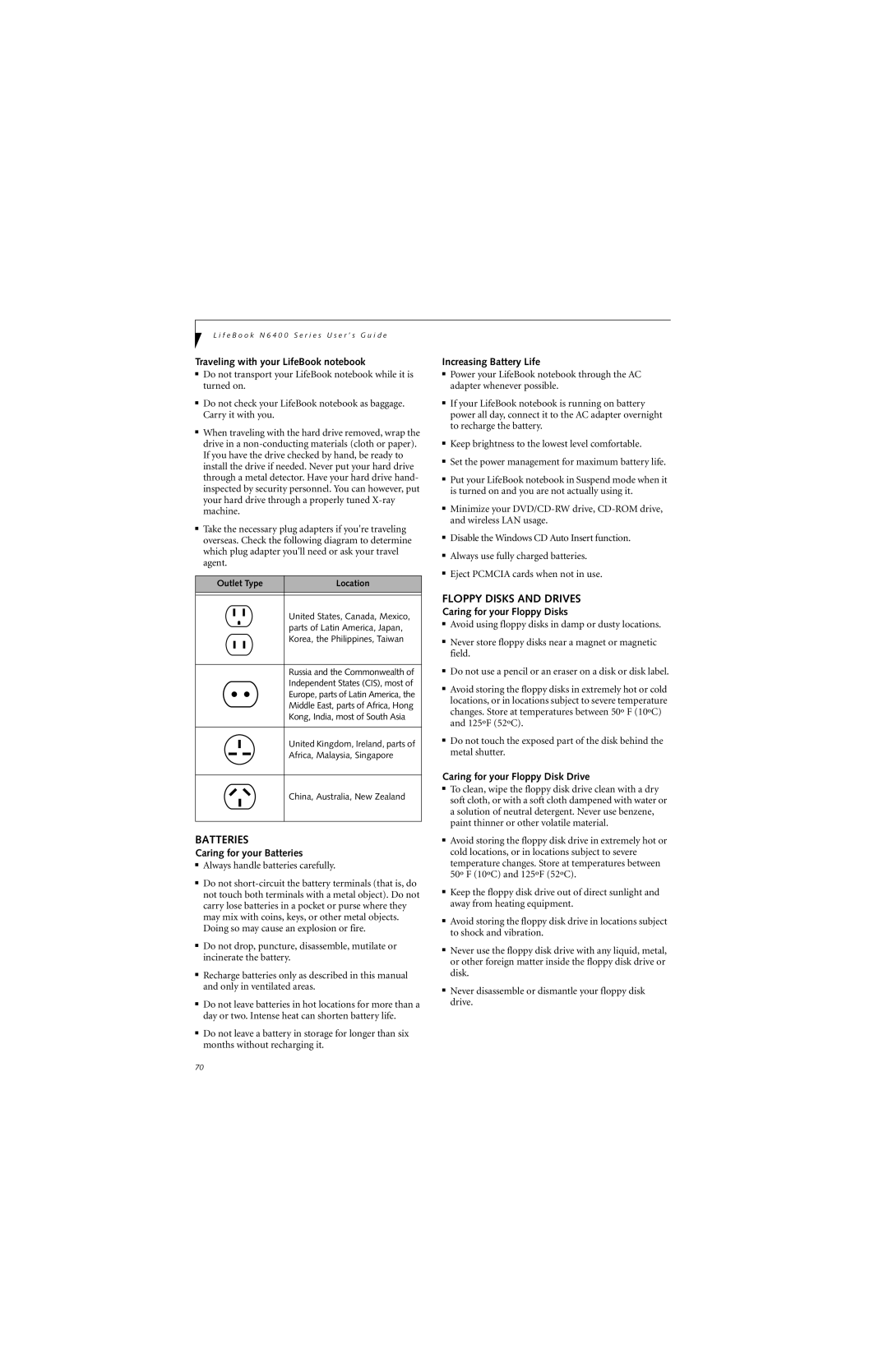
L i f e B o o k N 6 4 0 0 S e r i e s U s e r ’ s G u i d e
Traveling with your LifeBook notebook
■Do not transport your LifeBook notebook while it is turned on.
■Do not check your LifeBook notebook as baggage. Carry it with you.
■When traveling with the hard drive removed, wrap the drive in a
■Take the necessary plug adapters if you're traveling overseas. Check the following diagram to determine which plug adapter you'll need or ask your travel agent.
Outlet Type | Location |
|
|
United States, Canada, Mexico, parts of Latin America, Japan, Korea, the Philippines, Taiwan
Russia and the Commonwealth of
Independent States (CIS), most of
Europe, parts of Latin America, the
Middle East, parts of Africa, Hong
Kong, India, most of South Asia
United Kingdom, Ireland, parts of
Africa, Malaysia, Singapore
China, Australia, New Zealand
BATTERIES
Caring for your Batteries
■Always handle batteries carefully.
■Do not
■Do not drop, puncture, disassemble, mutilate or incinerate the battery.
■Recharge batteries only as described in this manual and only in ventilated areas.
■Do not leave batteries in hot locations for more than a day or two. Intense heat can shorten battery life.
■Do not leave a battery in storage for longer than six months without recharging it.
Increasing Battery Life
■Power your LifeBook notebook through the AC adapter whenever possible.
■If your LifeBook notebook is running on battery power all day, connect it to the AC adapter overnight to recharge the battery.
■Keep brightness to the lowest level comfortable.
■Set the power management for maximum battery life.
■Put your LifeBook notebook in Suspend mode when it is turned on and you are not actually using it.
■Minimize your
■Disable the Windows CD Auto Insert function.
■Always use fully charged batteries.
■Eject PCMCIA cards when not in use.
FLOPPY DISKS AND DRIVES
Caring for your Floppy Disks
■Avoid using floppy disks in damp or dusty locations.
■Never store floppy disks near a magnet or magnetic field.
■Do not use a pencil or an eraser on a disk or disk label.
■Avoid storing the floppy disks in extremely hot or cold locations, or in locations subject to severe temperature changes. Store at temperatures between 50º F (10ºC) and 125ºF (52ºC).
■Do not touch the exposed part of the disk behind the metal shutter.
Caring for your Floppy Disk Drive
■To clean, wipe the floppy disk drive clean with a dry soft cloth, or with a soft cloth dampened with water or a solution of neutral detergent. Never use benzene, paint thinner or other volatile material.
■Avoid storing the floppy disk drive in extremely hot or cold locations, or in locations subject to severe temperature changes. Store at temperatures between 50º F (10ºC) and 125ºF (52ºC).
■Keep the floppy disk drive out of direct sunlight and away from heating equipment.
■Avoid storing the floppy disk drive in locations subject to shock and vibration.
■Never use the floppy disk drive with any liquid, metal, or other foreign matter inside the floppy disk drive or disk.
■Never disassemble or dismantle your floppy disk drive.
70
